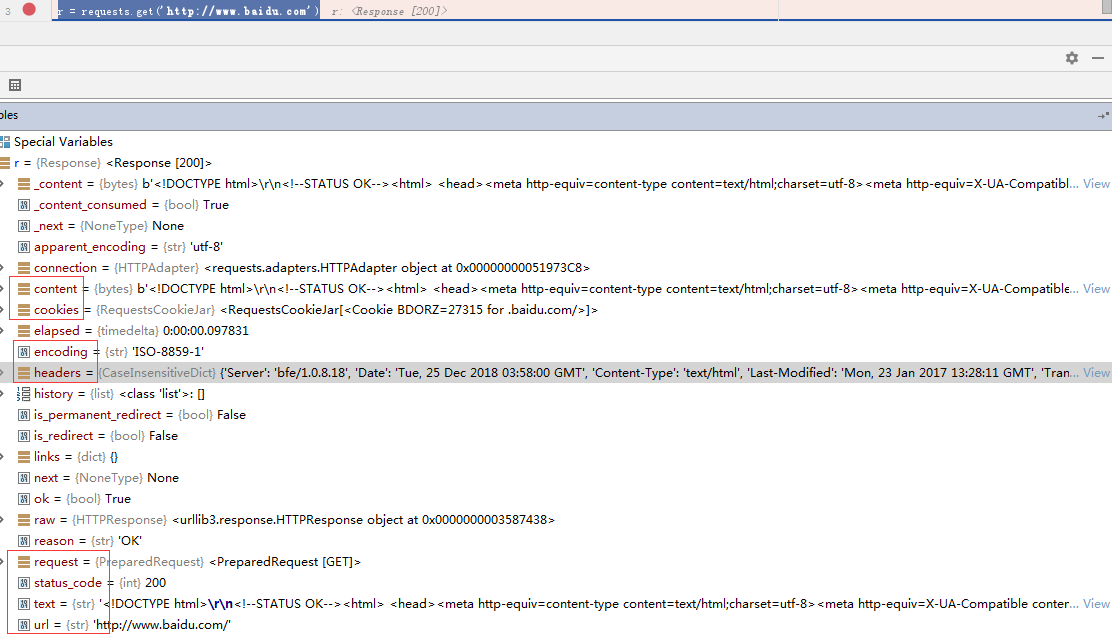python之requests模块快速上手
安装
pip3 install requests
使用
发送请求
import requests r = requests.get('http://www.baidu.com')

还可以如下方式发送不同类型请求:
r = requests.post('http://httpbin.org/post', data = {'key':'value'}) r = requests.put('http://httpbin.org/put', data = {'key':'value'}) r = requests.delete('http://httpbin.org/delete') r = requests.head('http://httpbin.org/get') r = requests.options('http://httpbin.org/get')
传递URL参数
import requests # 传递字典 payload = {'key1': 'value1', 'key2': 'value2'} r = requests.get("http://httpbin.org/get", params=payload) print(r.url) # http://httpbin.org/get?key1=value1&key2=value2 # 传递字典套列表 payload = {'key1': 'value1', 'key2': ['value2', 'value3']} r = requests.get('http://httpbin.org/get', params=payload) print(r.url) # http://httpbin.org/get?key1=value1&key2=value2&key2=value3
响应文本内容
import requests r = requests.get('https://www.baidu.com') print(r.encoding) # ISO-8859-1 查看编码 r.encoding = 'utf8' # 设置编码 print(r.text)
二进制响应内容
import requests r = requests.get('https://assets.readthedocs.org/sustainability/jetbrains/pycharm3-fs8.png') file_name = r.url.rsplit('/', maxsplit=1)[1] with open(file_name, 'wb') as img_file: img_file.write(r.content)
JSON响应内容
import requests # 如果响应内容是 JSON 格式,就可以直接通过r.json()将 json 数据转换为字典 r = requests.get('https://api.github.com/events') print(r.json())
定制请求头
import requests url = 'https://api.github.com/some/endpoint' headers = {'user-agent': 'my-app/0.0.1'} r = requests.get(url, headers=headers)
复杂POST请求
import requests # 传递字典 payload = {'key1': 'value1', 'key2': 'value2'} r = requests.post("http://httpbin.org/post", data=payload) ''' { "key2": "value2", "key1": "value1" } ''' # 传递元组 payload = (('key1', 'value1'), ('key1', 'value2')) r = requests.post('http://httpbin.org/post', data=payload) ''' { "key1": [ "value1", "value2" ] } ''' # 传递 JSON import json url = 'http://127.0.0.1:5000/' payload = {'some': 'data'} r = requests.post(url, data=json.dumps(payload)) # 此处除了可以自行对 dict 进行编码,你还可以使用 json 参数直接传递,然后它就会被自动编码 r = requests.post(url, json=payload)
POST一个多部分编码(Multipart-Encoded)的文件
import requests # 上传文件 url = 'http://httpbin.org/post' files = {'file': open('report.xls', 'rb')} r = requests.post(url, files=files) # 显式地设置文件名,文件类型和请求头 url = 'http://httpbin.org/post' files = {'file': ('report.xls', open('report.xls', 'rb'), 'application/vnd.ms-excel', {'Expires': '0'})} r = requests.post(url, files=files) # 发送作为文件来接收的字符串 url = 'http://httpbin.org/post' files = {'file': ('report.csv', 'some,data,to,send\nanother,row,to,send\n')} r = requests.post(url, files=files)
响应状态码
import requests r = requests.get('http://www.baidu.com') # 为方便引用,Requests 还附带了一个内置的状态码查询对象: print(r.status_code == requests.codes.ok) # 如果发送了一个错误请求(一个 4XX 客户端错误,或者 5XX 服务器错误响应),我们可以通过 Response.raise_for_status() 来抛出异常 bad_r = requests.get('http://httpbin.org/status/500') print(bad_r.status_code) # 500 bad_r.raise_for_status() # requests.exceptions.HTTPError: 500 Server Error
响应头
import requests r = requests.get('http://www.baidu.com') # 以查看以一个 Python 字典形式展示的服务器响应头: print(r.headers) ''' { 'Server': 'bfe/1.0.8.18', 'Date': 'Tue, 25 Dec 2018 06:41:43 GMT', 'Content-Type': 'text/html', 'Last-Modified': 'Mon, 23 Jan 2017 13:28:11 GMT', 'Transfer-Encoding': 'chunked', 'Connection': 'Keep-Alive', 'Cache-Control': 'private, no-cache, no-store, proxy-revalidate, no-transform', 'Pragma': 'no-cache', 'Set-Cookie': 'BDORZ=27315; max-age=86400; domain=.baidu.com; path=/', 'Content-Encoding': 'gzip' } ''' # HTTP 头部是大小写不敏感的。因此,我们可以使用任意大小写形式来访问这些响应头字段 print(r.headers['Content-Type']) # text/html print(r.headers.get('content-type')) # text/html
Cookie
import requests # 如果某个响应中包含一些 cookie,你可以快速访问它们 url = 'http://example.com/some/cookie/setting/url' r = requests.get(url) print(r.cookies['example_cookie_name']) # 要想发送你的cookies到服务器,可以使用 cookies 参数 url = 'http://httpbin.org/cookies' cookies = dict(cookies_are='working') r = requests.get(url, cookies=cookies) # Cookie 的返回对象为 RequestsCookieJar,它的行为和字典类似,但接口更为完整,适合跨域名跨路径使用。你还可以把 Cookie Jar 传到 Requests 中 jar = requests.cookies.RequestsCookieJar() jar.set('tasty_cookie', 'yum', domain='httpbin.org', path='/cookies') jar.set('gross_cookie', 'blech', domain='httpbin.org', path='/elsewhere') url = 'http://httpbin.org/cookies' r = requests.get(url, cookies=jar)
重定向与请求历史
import requests # 默认情况下,除了 HEAD, Requests 会自动处理所有重定向。 # 可以使用响应对象的 history 方法来追踪重定向。 # Response.history 是一个 Response 对象的列表,为了完成请求而创建了这些对象。这个对象列表按照从最老到最近的请求进行排序。 # 例如,Github 将所有的 HTTP 请求重定向到 HTTPS: r = requests.get('http://github.com') print(r.url) # https://github.com/ print(r.history[0].url) # http://github.com/ # 如果你使用的是 GET、OPTIONS、POST、PUT、PATCH 或者 DELETE,那么你可以通过 allow_redirects 参数禁用重定向处理: r = requests.get('http://github.com', allow_redirects=False) print(r.url) # http://github.com/ print(r.history) # [] # 如果你使用了 HEAD,你也可以启用重定向: r = requests.head('http://github.com', allow_redirects=True)
超时
import requests # 可以告诉 requests 在经过以 timeout 参数设定的秒数时间之后停止等待响应: requests.get('http://github.com', timeout=0.001) ''' Traceback (most recent call last): File "<stdin>", line 1, in <module> requests.exceptions.Timeout: HTTPConnectionPool(host='github.com', port=80): Request timed out. (timeout=0.001) '''
错误与异常
遇到网络问题(如:DNS 查询失败、拒绝连接等)时,Requests 会抛出一个 ConnectionError 异常。
如果 HTTP 请求返回了不成功的状态码, Response.raise_for_status() 会抛出一个 HTTPError 异常。
若请求超时,则抛出一个 Timeout 异常。
若请求超过了设定的最大重定向次数,则会抛出一个 TooManyRedirects 异常。
所有 Requests 显式抛出的异常都继承自 requests.exceptions.RequestException 。
更多
参考:http://docs.python-requests.org/zh_CN/latest/index.html
示例
requests和bs4爬取汽车之家文章和图片
from gevent import monkey monkey.patch_all() import gevent import requests import bs4 def save_detail(title, url_txt): article_detail_text = requests.get(url_txt).text detail_soup = bs4.BeautifulSoup(article_detail_text, features="html.parser") div_content = detail_soup.find(name='div', id='articleContent') p_img_list = div_content.find_all(name='p', attrs={'align': 'center'}) for p_img in p_img_list: if p_img.find(name='img') != None and p_img.find(name='img').attrs != None: src = 'https:' + p_img.find(name='img').attrs.get('src') filename = src.rsplit('/', maxsplit=1)[1] img_resp = requests.get(src) with open('images/%s' % filename, 'wb') as f: f.write(img_resp.content) line_arr = [] if (div_content != None): print(div_content.text) for line in div_content.find_all(name='p', align=False, recursive=False): line_arr.append(line.text) content = '\r\n'.join(line_arr) f = open('auto_home_articles/%s.txt' % title.replace('/', ' '), 'w+', encoding="utf-8") f.write(content) f.close() def get_list_url(): response = requests.get('https://www.autohome.com.cn/news/') response.encoding = 'gbk' list_soup = bs4.BeautifulSoup(response.text, features="html.parser") # 获取最大页数 ul_page = list_soup.find(name='div', id='channelPage', class_='page') max_page_num = int(ul_page.find(class_='page-item-next').find_previous(name='a').text) list_url_template = 'https://www.autohome.com.cn/news/%s/#liststart' return [list_url_template % i for i in range(1, max_page_num + 1)] def start_save(list_url): list_page_resp = requests.get(list_url) list_page_resp.encoding = 'gbk' list_page_soup = bs4.BeautifulSoup(list_page_resp.text, features="html.parser") div = list_page_soup.find(name='div', id='auto-channel-lazyload-article') article_ul = div.find_all(name='ul', attrs={'class': 'article'}) detail_url_list = [] for article_list in article_ul: article_group = article_list.find_all(name='a') for article_item in article_group: title = article_item.find(name='h3').text url = article_item.attrs.get('href').replace('//', 'http://') detail_url_list.append((title, url,)) gevent.joinall([gevent.spawn(save_detail, detail_url[0], detail_url[1]) for detail_url in detail_url_list]) [start_save(list_url) for list_url in iter(get_list_url())]
Java博客目录 | Python博客目录 | C#博客目录



